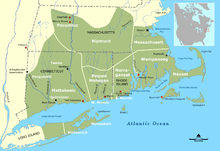 The Quinnipiac River looking west into the Quinnipiac River Gorge The Quinnipiac River looking west into the Quinnipiac River Gorge | |
| Total population | |
|---|---|
| extinct as a tribe; merged into the Stockbridge Munsee Community and Brotherton Indian Community, now in Wisconsin | |
| Regions with significant populations | |
| United States (Connecticut) | |
| Languages | |
| Quiripi language | |
| Religion | |
| Indigenous religion | |
| Related ethnic groups | |
| other Wappinger peoples |
The Quinnipiac were a historical Indigenous people of the Northeastern Woodlands. They lived in present-day New Haven County, Connecticut, along the Quinnipiac River. Their primary village, also called Quinnipiac, was where New Haven, Connecticut is today.
Name
The Quinnipiac name translates as "Long-water people." It was also spelled Quienepiage, Quenepiake, Qunnipiéuk, Qunnipiuck, Qunnipiug, Quinnpiipuck, Quunnipieuck, and Qvinipiak.
Language
The Quinnipiac and several neighboring tribes in central Connecticut and central Long Island all spoke the Quiripi language. This Eastern Algonquian language went extinct in the late 19th century. Reverend Abraham Pierson translated the catechism into Quiripi in 1658. Reverend Ezra Stiles and Thomas Jefferson both collected word lists in the language.
Political structure
Historian Edward Manning Ruttenber suggested that the Quinnipiac were part of the Wappinger confederacy, but the colonist Daniel Gookin wrote that they were part of the Pequot. Their leader was called a sachem, and historians invented the term sachemdom to describe political units led by a sachem. The Totoket people were part of the Quinnipiac sachemdom. The Hammonasset were likely also part of the Quinnipiac sachemdom.
History
17th century

The Puritans established the first Indian Reservation in 1638. Located near New Haven, Connecticut, the reserve was for the Quinnipiac, but only included 1,200 acres, a small portion of their original territory. The reservation's residents, described as "free" Indians, were placed under the authority of an English agent. They were not allowed to sell or abandon that land, and Native peoples from other tribes were not allowed to visit.
From around 1651 to 1669, Reverend Abraham Pierson, a Congregational minister, proselytized the Quinnipiac near Branford, Connecticut. He translated Christian texts into the Quiripi language. Missionization was not very successful, and the tribe showed "a perverse contempt" for the church.
18th century
In 1730, there were an estimated 250 to 300 Quinnipiac. In 1768, some Quinnipiac left their reservation and joined the Tunxi near Farmington, Connecticut. In 1774, only an estimated 38 Quinnipiac survived. They were part of the large Mahican tribe, whose descendants ultimately migrated to Wisconsin with the Stockbridge Munsee Community and Brotherton Indian Community.
References
- ^ Ricky, Donald B. (1999). Indians of Maryland. St. Clair Shoes, MI: Somerset. p. 232. ISBN 9780403098774.
- John Reed Swanton, The Indian Tribes of North America, pp. 45–46.
- ^ Hodge, p. 345.
- ^ Hodge, p. 344.
- Hodger, p. 1127.
- ^ "Quiripi". Omniglot. Retrieved 5 April 2023.
- John Reed Swanton, The Indian Tribes of North America, p. 47.
- Frederick Webb Hodge, Handbook of American Indians North of Mexico, p. 529.
- ^ Schultz et al., Encyclopedia of Minorities in American Politics, 677
- ^ Frederick Webb Hodge, Handbook of American Indians North of Mexico, p. 883.
Sources
- Aoki, Andrew L.; Schultz, Jeffrey D.; Kaynie, Kerry L., eds. (2000). Encyclopedia of Minorities in American Politics: Hispanic Americans and Native Americans. Phoenix, AZ: Oryx Press. ISBN 978-1-57356-149-5.
- Hodge, Frederick Webb (1910). Handbook of American Indians North of Mexico: N-Z. Washington, DC: U.S. Government Printing Office.
- Swanton, John Reed (1952). The Indian Tribes of North America. Genealogical Publishing Com. pp. 102–03. ISBN 9780806317304.
External links
 Media related to Quinnipiac at Wikimedia Commons
Media related to Quinnipiac at Wikimedia Commons- Stockbridge-Munsee Community Band of Mohican Indians, official website